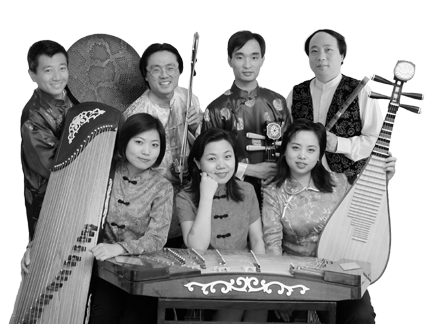The music on this page IS playable
Yes, the MP3 library on most of our pages is not available, but the music has been preserved on this page
Deborah's
Koh's MP3 Page of Chinese Folk Music
by
Deborah Koh
Click HERE
to find out about more about this remarkable young lady and her
love of music.
Tian
Shan Sheng Hui
(Festival on Mt. Tian)
This is a lively song by Gu Guanren, but with a strong tribal
flavor to it that makes it very unique among Chinese orchestral
pieces. It symbolizes the festival held on Mt. Tian (Mt. Sky)
where the Chinese minority tribes congregated and danced the
night away. Both fast and slow melodies are woven together into
a music that does not lose its ability to make the listener
dance along with it. Click
Here for a Detailed Description
Zhan
Tai Feng
(Combating
the Typhoon)
This is a guzheng solo piece composed by Wang Chang Yuan. The
guzheng (zither) is an instrument similar in principle to the
harp. There are several segments where heavy strumming is
involved, a technique that is commonly referred to as sao
xian, or “sweeping the strings”. Lots of furious
glissando is used too. This is to portray the fury and strength
of the typhoon winds. The pentatonic scale (do re mi so la do)
is quite evident here, with a melody somewhere in the middle
that goes “La do re la, la do re mi, mi re do re mi re mi so
la…”

This is
"Melody of China," a group based in San Francisco. In
the front row on the left is the guzheng, in the middle
the yangqin, and on the right, the pipa.
Zhu
Ying Yao Hong (Flickering of the Candle Flame)
An erhu solo piece with yangqin (dulcimer) as accompaniment. It
was composed by Liu Tianhua in 1932. Unfortunately, he died of
scarlet fever that very year.
Kong
Shan Niao Yu
(Bird-call
on an Empty Mountain)
Yet another erhu solo piece with yangqin as accompaniment, also
composed by Liu Tianhua. It is very unique in the way that it
displays the wonderful ability the erhu has in mimicking
bird-calls. The
erhu does not have frets in the way a guitar has, nor a
fingerboard like a violin. It merely has 2 strings stretched
taut in mid-air. This allows an amazing variety of sounds to be
produced due to changes in the pressure of depressing the
string.
The
second half of the song is where the true action starts. When
performed live by a virtuoso, it is an amazing sight. The erhu
player sweeps from the top of the strings all the way to the
bottom of the strings and back up again, with utter confidence
that he or she is playing the exact right note, even though
there are no frets and the hand is moving impossibly fast, with
the fingers just grazing the strings.
In
order to achieve this special effect, the same note is played in
swift succession by three different fingers. So, for example,
the notes “do do do” would be played by the ring finger, the
third finger and then the second finger at super-fast speed,
causing a slight blurring of the notes. All these techniques
result in squeaks and calls that sound remarkably like that of a
bird.
The
erhu can also mimic the sound of neighing horses as well as a
snowstorm quite convincingly.
Bu
Bu Gao (Stepping
Higher)
This
is a gaohu solo piece, with a chamber orchestra as
accompaniment. The melody is bright and lively, which is brought
out to perfection by the unique timbre of the gaohu. On the
whole, this is a very toe-tapping song, from Guangdong (Canton)
province.
|

